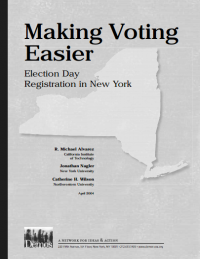As policymakers, election officials, and the public consider whether New York should change the way in which voters are allowed to register to participate in elections, and bring New York State election law into compliance with the Help America Vote Act, we provide an analysis of the potential impact of election day registration (EDR) in New York. The current system of registration is one in which citizens must register 25 days before election day in order to be eligible to vote.1 Under EDR this advance registration barrier would be eliminated as citizens could register on election day.
It is important to note that our analysis of the effects of EDR on turnout is based on the experiences of other EDR states, which allow same day registration at the polling place. A legislative proposal currently under consideration in New York (A.5762) would require voters to register on election day at a location other than the polling place. Hence, the actual impact on turnout of EDR in New York is likely be less than the estimates we report here. This is because EDR in New York would entail two steps: registration at a local board of elections, and then casting a ballot at the appropriate local polling place. A second bill, A.5800, would rescind the current state constitutional requirement that voter registration take place at least 10 days before elections.
Our findings may be broadly categorized in three ways. First, EDR should help increase voter registration and turnout in New York. In particular, our analysis finds that adjusting for the effects of age, mobility, and many other factors, New York could see its long-run turnout rate increase by as much as 8.6 percentage points in presidential elections. This means that turnout in the 2000 presidential election in New York could have been as high as 59 percent if EDR had been in place.
Second, EDR is likely to make voting easier for citizens who have the most difficulty maintaining an up-to-date voter registration record in New York. Our analysis predicts as much as:
A 12.3 percentage point increase in turnout by 18-to-25-year-olds.
A 9.8 percentage point increase in turnout by those with a grade school education or less.
An 11 point increase in turnout by Latinos and an 8.7 percentage point increase in turnout by African Americans.
A 10.1 percentage point increase in turnout by those who have lived at their current address for less than six months.
A 12.2 percentage point increase in turnout by naturalized citizens.
Third, New York could mitigate or avoid the problems commonly advanced by EDR opponents: added burdens on election administration, cost, and potential voter fraud. We address these concerns below. We show that states like Minnesota and Wisconsin that currently use EDR have developed effective laws and procedures that serve to minimize or eliminate these problems. We argue that should New York move to EDR, it too could mitigate or eliminate these problems through effective laws and procedures. And there is no reason to believe that implementation, as described in A.5762, would lead to increased voter fraud.
